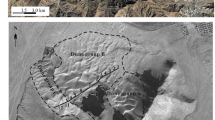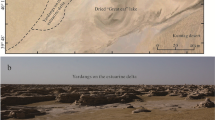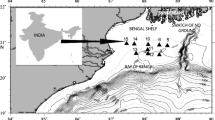Abstract
Dry lakes, degraded sandy grasslands, abandoned farmland and mobile dunes which are widely distributed throughout the arid areas of northern China have been investigated in this work. Gain-size distribution of the surface sediments of Manas lake in Junggar basin, Juyan lake in the Alxa plateau, Zhuye lake in Minqin basin and most deserts (such as Mu Us desert, Otindag desert, Horqin desert and Hulun Buir desert) in China have been analyzed. The results show clay with particle sized <10 μm on the surface sediments of dry lakebed and sandy grassland developed from dry lakebed, respectively, account for >60% and ∼50% of the total mass. Since the tiny particles on the surface of abandoned farmland are blown away easily and rapidly, the content of clay particles in Minqin basin is <14%. The grain-size distribution of mobile dunes in northern China mainly consists of particles >63 μm and few particles <10 μm. Consequently, although sand/dust storms originate primarily in the western deserts, the gobi areas of the Alxa plateau, the north and east of Hexi Corridor and in central Mongolia, the widely distributed dry lakebeds, sandy grasslands and abandoned farmland adjacent to the deserts also contribute to aeolian dusts. Hence, the material sources for sand dust storm in East Asia include inland deserts, but also dry lakes, sandy grasslands and abandoned farmland, which are widely distributed throughout the arid inlands of northern China.





Similar content being viewed by others
References
Cheng WM, Zhou CH, Li JX (2001) Evolution of Manas lake landscape in Xinjiang and its ECO-environmental effect (in Chinese). Quaternary Sci 21(6):560–565
Chung YS, Kim HS, Dulam J, Harirs J (2003) On heavy dustfall observed with explosive sandstorm in Chongwon-Chongju, Korea in 2002. Atmos Environ 37(24):3425–3433
Darmenova K, Sokolik IN, Darmenov A (2005) Characterization of east Asian dust outbreaks in the spring of 2001 using ground-based and satellite data J Geophys Res 110(D2): D02204
Ding ZL, Sun JM, Rutter NW, Rokosh D, Liu TS (1999) Changes in sand content of loess deposits along a north–south transect of the Chinese Loess plateau and the implications for desert variations. Quaternary Res 52(1):56–62
Duce RA, Unni CK, Ray BJ, Prospero JM, Merrill JT (1980) Long-range atmospheric transport of soil dust from Asia to the tropical North Pacific: temporal variability. Science 209(4464):1522–1524
Jaffe D, Anderson T, Covert D, Kotchenruther R, Trost B, Danielson J, Simpson W, Berntsen T, et al (1999) Transport of Asian air pollution to North America. Geophys Res Lett 26(6):711–714
Kurtz AC, Derry LA, Chadwick OA (2001) Accretion of Asian dust to Hawaiian soils: isotopic, elemental, and mineral mass balances. Geochim Cosmochim Acta 12(65):1971–1983
Liu TS, Gu XF, An ZS, Fan YX (1981) The dust fall in Beijing, China on April 18,1980. Geol Soc Am Spec Pap 186:149–157
Ma JZ, Wang XS, Edmunds WM (2005) The characteristics of ground-water resources and their changes under the impacts of human activity in the arid Northwest China—a case study of the Shiyang River basin. J Arid Environ 61(2):277–295
McKendry IG, Hacker JP, Stull R, Sakiyama S, Mignacca D, Reid K (2001) Long-range transport of Asian dust to the Lower Fraser Valley, British Columbia, Canada. J Geophys Res 106(D16):18361–18370
Sun JM, Liu TS, Lei ZF (2000) Source of heavy dust fall in Beijing, China on April 16,1998. Geogr Res Lett 27(14):2105–2108
Tsoar H, Pye K (1987) Dust transport and question of desert loess formation. Sedimentology 34(1):139–153
Wang SM, Dou HS (eds) (1998) Chinese lakes, Science Press, Beijing
Wang GX, Cheng GD (1999) Water resource development and its influence on the environment in arid, areas of China—the case of the Hei River basin. J Arid Environ 43(2):121–131
Wang G, Cheng G (2000) The characteristics of water resources and the changes of the hydrological process and environment in the arid zone of northwest China. Environ Geol 39(7):783–790
Wang NA, Zhao Q, Hu G, Kan YS (2003) Climatic and humanistic background of desertification process in the recent 2000 years in Hexi Corridor (in Chinese). China J Desert Res 23(1):95–100
Zdanowicz C, Hall G, Vaive J, Amelin Y, Percival J, Girard I, Biscaye P, Bory A (2006) Asian dustfall in the St. Elias Mountains, Yukon, Canada. Geochim Cosmochim Acta 70(14):3493–3507
Zhang XY (2001) Source distributions, emission, transport, deposition of Asian dust and loess accumulation (in Chinese). Quarternary Sci 21(1):29–40
Zhang DE, Lu F (1999) Winter sandstorm events in extensive Northern China (in Chinese). Quaternary Sci 5:441–447
Zhang XY, Arimoto R, An ZS (1997) Dust emission from Chinese desert sources linked to variations in atmospheric circulation. J Geophys Res 102(D23):28041–28047
Zhang J, Wu Y, Liu CL, Shen ZB, Yu ZG, Zhang Y (2001) Aerosol characters from desert region of Northwest China and the Yellow Sea in spring and summer: observations at Minqin, Qingdao, and Qianliyan in 1995–1996. Atmos Environ 35(29):5007–5018
Zhang Q, Zhao CS, Tie XX, Wei Q, Huang MY, Li GH, Ying ZM, Li CC (2006) Characterizations of aerosols over the Beijing region: a case study of aircraft measurements. Atmos Environ 40(24):4513–4527
Zhou ZJ (2001) Blowing-sand and sandstorm in China in recent 45 years (in Chinese). Quaternary Sci 21(1):9–17
Zhou M, Okada K, Qian F, Wu PM, Su L, Casateto BE, Shimohara T (1996) Characteristics of dust-storm particles and their long-range transport from China to Japan—case studies in April 1993. Atmos Res 40(1):19–31
Acknowledgements
This work was financially supported by the key project of China Geological Survey (Grant no.200112300004, 20024017), National project 973 (Grant no.2003CB214607), and SKLLQG0511. We thank Mr. H.J. Gong for providing aeolian dust samples from Xi’an. The authors are very grateful for Prof. Friedrich Heller for his critical comments on improving the manuscript.
Author information
Authors and Affiliations
Corresponding author
Rights and permissions
About this article
Cite this article
Yang, Lr., Yue, Lp. & Li, Zp. The influence of dry lakebeds, degraded sandy grasslands and abandoned farmland in the arid inlands of northern China on the grain size distribution of East Asian aeolian dust. Environ Geol 53, 1767–1775 (2008). https://doi.org/10.1007/s00254-007-0782-y
Received:
Accepted:
Published:
Issue Date:
DOI: https://doi.org/10.1007/s00254-007-0782-y




